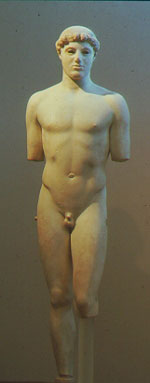
Greek art: A slave woman plays a kithara (Athens, ca. 480 BC)
Greek art: order and chaos
Artists in ancient Greece thought of art as a way of creating order out of chaos – taming wild things and making them into something human and good.
Order and chaos
Gaia and Chaos
Greek religion
All our ancient Greece articles
Music in ancient Greece
Greek musicians took noise and turned it into regular patterns of sound, with rhythms, melodies, and harmonies. Greek musicians sang songs and played the lyre and pipes and a kind of tambourine.
Ancient Greek music
Greek philosophy
Ancient Greek mathematics
Greek philosophers like Pythagoras tried to figure out the mathematical patterns of music: how music and numbers were related to each other. Greek plays, which started as a kind of musical performance, brought music together with explorations of ethical questions and contrasted irrational emotion (often personified by female characters) with calm reasoning (often embodied by male characters).

Ancient Greek art: Kritios Boy (Athens, ca. 480 BC)
Gre
Ancient Greek architecture
Greek architects also thought of their buildings as bringing order out of chaos; they took unformed rocks and carved them into regular blocks, and used them to form temples. They thought that architecture and music shared an interest in rhythm.
Greek architecture
Rhythm and Greek temples

Ancient Greek art: Achilles kills Penthesileia just at the moment that they fall in love (Athens, ca. 540 BC)
Greek sculpture
Greek sculpture was the same way. Sculptors carved the naked male body, the height of perfect reason and control. They showed these men fighting scary forces of chaos. They fought centaurs, Amazons, giants, foreigners, and monsters.
Greek sculpture
Nude women only came into Greek sculpture with the Hellenistic, as part of an artistic movement to carve chaos itself that also brought statues of foreigners, drunks, old people, and children.
Ancient Greek painting
Greek painters were concerned with the same issues. In the Bronze Age they painted battles between men and their enemies.
Greek painting
Black figure pottery
Red figure pottery
In the Classical period, Greek pottery shows us, once again, scenes of the struggle between order and chaos: men fighting monsters, satyrs drinking and partying. But the paintings, which more often represent gods, also show us that to the Greeks, the gods themselves were often forces of chaos, and religious ritual represented man’s effort to control the gods and force them into the realm of reason.
Did you find out what you wanted to know about Greek art? Let us know in the comments!
Learn by doing: Greek vase painting
More about Greek music
Bibliography and further reading about ancient Greek art:
Ancient Greek Art, by Susie Hodge (1998)- easy reading.
Greek Art and Archaeology (3rd Edition), by John G. Pedley (2002) A lot of good information and is pretty readable. Plus, the author is really an expert in this field.
The Archaeology of Greece: An Introduction, by William R. Biers (revised edition 1996) Biers writes very clearly and has a lot of good pictures.




